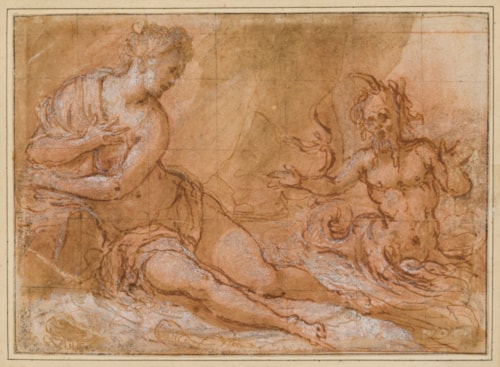
Jacopo da EMPOLI
Florence 1551 - Florence 1640
Biography
According to his biographer Filippo Baldinucci, Jacopo da Empoli’s first teacher was Tommaso Manzuoli, called Maso da San Friano. He entered the Accademia del Disegno in 1576, and spent his entire career in Florence, apparently never leaving the city to work elsewhere. Empoli’s earliest documented painting is a Virgin with Saints of 1579, now in the Louvre. Among his most significant works is an altarpiece of the Immaculate Conception, painted in 1591 for the Florentine church of San Remigio, and a Doubting Thomas of 1602, now in the Museo della Collegiata in his home town of Empoli. Between 1600 and 1620 Jacopo da Empoli was particularly active in painting altarpieces for churches in Florence, such for Santa Maria Novella, Santissima Annunziata and the Certosa at Galluzzo. He also earned a number of private commissions for religious works, notably a Supper at Emmaus painted in 1609 for the chapel of the Villa degli Albizzi at Pomino, outside Florence. Empoli was called upon by the Medici to provide decorations for such important occasions as the weddings of Ferdinando I de’ Medici and Christina of Lorraine in 1589 and Marie de’ Medici and Henri IV of France in 1600, as well as the funeral of Queen Margherita of Spain in 1612. Between 1617 and 1619 he worked on the decoration of the Casa Buonarroti in Florence. Empoli was a fine portrait painter, and also painted a number of still life pictures, of which fewer than a dozen survive, mostly datable to the 1620s. He is known to have established a private art school in his studio, to teach drawing to young artists and noblemen, in the latter part of his career.
Empoli was one of the finest Florentine draughtsmen of the early Seicento, and nearly a thousand of his drawings have survived to this day. As Richard Spear has noted, ‘Jacopo da Empoli’s paintings reveal a gradual but decided shift from Vasarian mannerism to Carraccesque naturalism and clarity; the drawings reflect a slow and meticulous personality, one attuned to methodical and repetitious study of gestures and compositional details.’ The artist produced many individual studies for each figure in his compositions, working from live models to study and refine details of drapery, gesture, pose and lighting, and several preparatory drawings - often on coloured or prepared paper - survive for most of his paintings. (Almost no drawings related to his still life subjects are known, however). In his old age, when he had largely ceased working as a painter, he was reduced to selling his drawings to provide income to live by. A large number of Empoli’s studies were thus purchased by Baldinucci, both for himself and for the inveterate collector Cardinal Leopoldo de’ Medici, so that by far the largest surviving group of drawings by the artist, numbering some four hundred sheets, is today in the Uffizi. (Many of Empoli’s drawings were also purchased by his pupil and first biographer, the minor still-life painter Virginio Zaballi.) A much smaller but equally representative selection of drawings by Empoli is in the Musée des Beaux-Arts in Lille, while other groups are in museums in Amsterdam, Berlin, London, Oxford, Paris and Rome.


